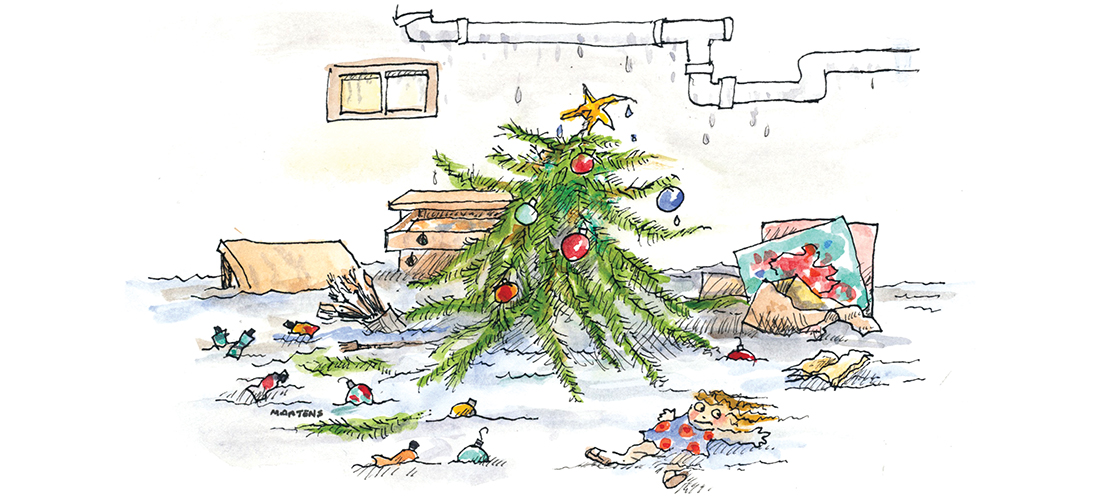
O Christmas Tree
Poor, rusted Christmas tree
By Ruth Moose
When water is up to your waist, the last thing you think about is Christmas. And certainly not Christmas trees. You rescue what you can at hand. You bless sump pumps and those who make them. Same goes for wet vacuums. You are amazed that sofas can swim, but armchairs cannot. And you cry over books. Thousands of pages, sodden wads of pages, glued together, their backs forever warped and bucked in humps and waves. How heavy they are as you cart them to the curb. How wasted their lives.
Hurricane Florence got all the publicity, but the hurricane after got us. In Albemarle, our usually sunny (and the site of my artist husband’s studio) daylight basement ended up with nearly 3 feet of water. At least it was clear, cold and clean water, but still a frightening sight. Here were my husband’s sketches and paintings, art books, art supplies and frames. His working easels and drawing board, paints and brushes. It’s a sickening feeling to pull open a drawer of paint tubes and water pours out. Not to mention a lifetime collection of art books with glorious color reproductions of paintings he’d used for study and inspiration. In other sections of the basement he also had a woodworking shop furnished with years of accumulated equipment and tools.
Then there was the household part of the basement with the water heater, furnace and 35-year-old food freezer, all standing in water. Plus various assorted items we’d stored over the years. Never had water, four sump pumps going simultaneously, receded so slowly. You can only haul furniture out to dry, watch the skies and wait. Pray. And when the water is gone, you wet vac and wet vac and wet vac. You hear the roar of the motor in your sleep.
Then you begin to dry out sketches and wipe off oil paintings and cry over lost watercolors who went to meet their medium. You open cabinet doors, and drawers and water pours out.
Somewhere in the flood I heard my librarian aunt’s voice when she said, more than once, she never trusted basements. Neither did she like attics. “Basements are too wet,” she said, “and attics are too dry.” At least I thought what we had stored in the attic was dry and better dry any day than wet, wet and wetter.
But, miracle of miracles, after the water went, the air conditioner came back on, the water heater began to purr and the ancient food freezer hummed its heart out. So I emptied and cleaned it and began all over again. Thirty-five years old, hauled through four complete household moves, the freezer kept going and going and going. Gave one heart and hope.
In all that water and wetness, nobody thought about the Christmas tree until months later. We were too busy mopping and drying out and saving what could be saved. When it came time to do the tree, we remember what had been in some of those sodden boxes in the basement. That artificial tree I’d argued and fought against and finally been persuaded (for ecological reasons) to tolerate. Not accept. All our married life my husband and I had fought the real vs. artificial Christmas tree fight. And for years I’d won. Real was a cedar tree that permeated the whole house with the smell of Christmas. No artificial tree had ever come close to that. For years we’d had the advantage of family land to tromp as a family, choose and cut a tree. We never found the perfect tree. Just ones that could be trimmed or branches spliced to suffice. It didn’t matter, as long as they were real. All Christmas trees when trimmed and lighted are beautiful.
When family lands were no longer available, I had no choice but an artificial tree. Somehow the picture of my husband assembling those branches that still look and feel — to me — like giant green bottle brushes, never matched the one in my memory of tramping through the woods on a winter Sunday, kids and dog ahead, ax and saw in hand, to bring home bundled and tied atop the station wagon, this year’s Christmas tree.
Thankfully, the tree ornaments and decorations were in the attic. The tree itself had been stored in boxes too big to go through the crawl space and had to go to the basement. The basement flooded. So we had dry ornaments and a rusty tree. We dried out the branches, shook the rust out, stuck them back into a shape that still looked like a pyramid of green bottle brushes and said, “Merry Christmas to all and to all a working sump pump.” PS
Ruth Moose taught creative writing at the University of North Carolina-Chapel Hill for 15 years and tacked on 10 more at Chatham County Community College.





